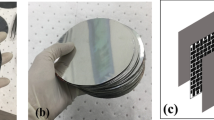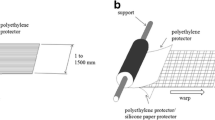A method of eliminating gaps between heat bonded glass plates has been developed using a system for distributing mechanical load. The proposed method was investigated theoretically and experimentally. The results of numerical and full-scale model experiments confirming the efficacy of the proposed method are presented.









Similar content being viewed by others
References
A. N. Agafonov, V. I. Platonov, A. M. Batalova, et al., “Development of the manufacturing technology of microfluidic systems on glass plates,” in: AIP Conference Proceedings. International Conference on Advanced Materials, ICAM 2019, New Delhi, 6 – 7 March 2019, American Institute of Physics Inc., New Delhi (2020), Vol. 2276, pp. 1 – 10.
I. A. Platonov, V. I. Platonov, I. N. Kolesnichenko, et al. “Microfluidic systems in gas analysis: a review,” Sorbts. Khromatogr. Protsessy, 15(6), 754 – 768 (2015).
K. I. Potienko and A. N. Agafonov, “Development of technology for manufacturing a microfluidic system based on silicon and glass substrates,” in: International Youth Scientific Conference, “15th Royal Readings,” Dedicated to the 100th Anniversary of the Birth of D. I. Kozlov: Collection of Works, Samara, October 8 – 10, 2019 [in Russian], Samara (2019), Vol. 1, pp. 415 – 416.
K. I. Milanina, A. N. Agafonov, and A. A. Lyapina, “A method of sealing microfluidic systems on glass substrates,” in: All-Russia Scientific and Technical Conference “Actual Problems of Radio Electronics and Telecommunications,” Samara, April 21 – 23, 2021 [in Russian], Samara (2021), pp. 114 – 116.
B. Renberg, K. Sato, T. Tsukahara, et al., “Hands on: thermal bonding of nano- and microfluidic chips,” Microchim. Acta, 166, 177 – 181 (2009); URL: https://doi.org/10.1007/s00604-009-0166-y
K. M. Knowles and A. T. J. van Helvoort, “Anodic bonding,” Int. Mater. Rev., 51(5), 273 – 311 (2006); https://doi.org/10.1179/174328006X102501
Zhi-Jian Jia, Qun Fang, and Zhao-Lun Fang, “Bonding of Glass Microfluidic Chips at Room Temperatures,” Anal. Chem., 76(18), 5597 – 5602 (2004); URL: https://doi.org/10.1021/ac0494477
Yu-Jen Pan and Ruey-Jen Yang, “A glass microfluidic chip adhesive bonding method at room temperature,” J. Micromechan. Microeng., 16(12), 2666 – 2672 (2006).
R. O. Claus, “Surface and near-surface defects in glass-to-glass bonds: Author affiliations,” Proc. SPIE, Optomechanical Systems Design, 0250 (1980); URL: https://doi.org/10.1117/12.959434
GOST 2789–73. International State Standard. Surface Roughness. Parameters and Characteristics (with Changes 1, 2) [in Russian], Standartinform, Moscow (2018).
J. Kentsch and S. Breisch, “Low temperature adhesion bonding for BioMEMS,” J. Micromechan. Microeng., 16(4), 802 – 807 (2006); https://doi.org/10.1088/0960-1317/16/4/017
GOST 24642–81. International Standard. Basic Norms of Interchangeability. Tolerances of the Shape and Location of Surfaces [in Russian], Izd. standartov, Moscow (2002).
GOST 9284–75. International State Standard. Glasses for Micropreparations. Specifications [in Russian], Izd. standartov, Moscow (1999).
Z. Chen, L. Zhang, and G. Chen, “A spring-driven press device for hot embossing and thermal bonding of PMMA microfluidic chips,” Electrophoresis, 31, 2512 – 2519 (2010); URL: https://doi.org/10.1002/elps.201000084
A. N. Agafonov, K. I. Milanina, T. A. Andreev, and V. I. Platonov, Pat. on Invention. 2766979 C1. A Method of Thermal Connection of Glass Plates with Microstructures on One of Their Surfaces [in Russian], application 2020139856 dated 12/02/2020; publ. March 16, 2022.
A. A. I’yushin, Proceedings, Vol. 3. Theory of Thermoviscoelasticity [in Russian], Fizmatlit, Moscow (2007).
I. I. Kitaigorodskii, Handbook of Glass Manufacture [in Russian], Gosstroiizdat, Moscow (1963), 1026 p.
Author information
Authors and Affiliations
Corresponding author
Additional information
Translated from Steklo i Keramika, No. 9, pp. 13 – 20, September, 2022.
Rights and permissions
Springer Nature or its licensor (e.g. a society or other partner) holds exclusive rights to this article under a publishing agreement with the author(s) or other rightsholder(s); author self-archiving of the accepted manuscript version of this article is solely governed by the terms of such publishing agreement and applicable law.
About this article
Cite this article
Milanina, K.I., Agafonov, A.N. & Andreeva, T.A. Method of Eliminating Flatness Defects of Heat Bonded Glass Plates. Glass Ceram 79, 358–362 (2023). https://doi.org/10.1007/s10717-023-00513-9
Received:
Published:
Issue Date:
DOI: https://doi.org/10.1007/s10717-023-00513-9




